Total Solar Eclipse of 24 October, 1995.
|
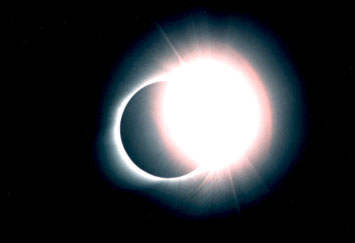 |
| Diamond ring, 13 seconds after third contact. Nikon N2020 with 300mm f/4.5 ED Nikkor Lens and Versacorp VersaScope Adapter (TM) with 2.1x Barlow lens. 1/30 sec. at f/9.5 on Kodachrome 64. All Images © Copyright 1995 (Registered 1998) Jeffrey R. Charles, All Rights Reserved. Use of material herein is subject to conditions in the Versacorp Legal Information Page. |
Images of the Total Solar Eclipse of 24 October, 1995.
Contents: |
Introduction:
|
The following images are from my 1995 eclipse expedition to Thailand. This expedition was a short one, but it was also the best international eclipse expedition I ever experienced. This is partly due to the fact that I was accompanied by another observer, Pierre-y Schwaar, who had the same agenda as myself -- observe and photograph the eclipse! In addition, the people of Thailand were extraordinarily friendly, as though they were ambassadors for their country. The eclipse of October 24, 1995 was my fourth total solar eclipse.
On this eclipse expedition, everything I brought fit in two standard size carry on bags. To photograph the corona, I used a 300 mm f/4.5 ED Nikkor lens, to which I had adapted the DiaGuider (TM), a patented product of my company, Versacorp. In order to increase the effective focal length of the lens to 640 mm and compensate for the extra back focus required for the depth of the DiaGuider, I designed and fabricated an adapter having a special cell which positions a Dakin Barlow lens a modest distance into the back recess of the lens. Since the DiaGuider allows instant switching of the image between the eyepiece and camera, the combination provides a very portable and easy to use photographic and visual telescope! When some people saw this telescope, they wanted to get one, so Versacorp also started supplying the Barlow lens section as "VersaScope (TM) adapter". In addition to photographing and observing the corona with the ED Nikkor lens and DiaGuider, I took video of the corona with an SVHS-C camcorder and a home made 3x converter lens. I also took several 360 degree Omniramic (TM) panoramic photos of the umbra with my indexing rotary camera platform, an all-sky shot with a 7.5 mm fisheye lens, photos of the eclipse over the horizon with a 14 mm rectilinear lens, and wide angle video of the umbra with a 0.45x converter lens stacked in front of a 0.7x converter lens. The images follow. |
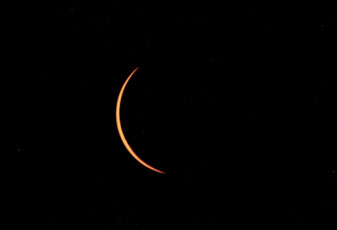 |
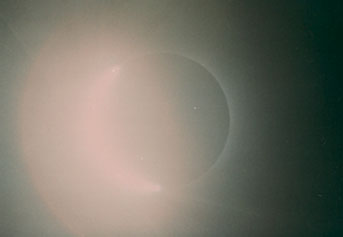 |
| Inner Corona Imaged Almost Two Minutes Before Totality | |
| Clear conditions made it possible to photograph the corona well before totality began. The left image was taken two minutes, forty two seconds before totality with the use of a solar filter. The right image was taken at 1/125 second without a solar filter. Even though this image was taken a full minute and forty six seconds before totality, the inner corona is already visible! | |
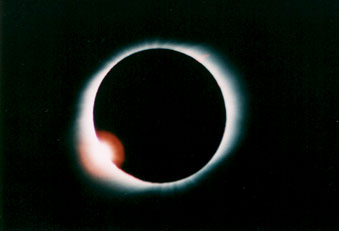 |
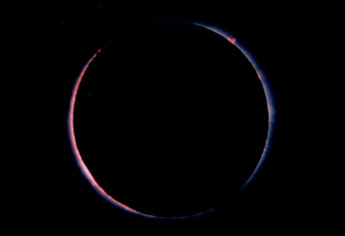 |
| Diamond Ring and Chromosphere at Beginning of Totality | The left image showing the last remnant of the diamond ring was taken at 1/30 second. The right image was taken four seconds later at 1/250 second. It shows the unusually long arc of chromosphere which is visible because the angular size of the sun and moon were nearly the same at this short eclipse. All of these images were taken on Kodachrome 64 film with a 300 mm f/4.5 ED Nikkor lens combined with the Versacorp DiaGuider and prototype VersaScope adapter. The focal length is 640 mm and the f/ratio is f/9.5. |
 |
 |
| Long Exposures of Corona and Earthshine | |
| The left image is scanned from a machine print of a one second exposure on Kodachrome 64 film. Earthshine on the moon is detectable in the right image, which is from the same slide. The original slide was printed directly onto black and white paper in order to gain contrast, then the resulting negative print was photographed with slide film and printed onto black and white paper to produce a positive. An original image having four times as much exposure would clearly show earthshine without any manipulation. I did not take such a long exposure due to the lack of a clock drive and the relative brevity of totality. | |
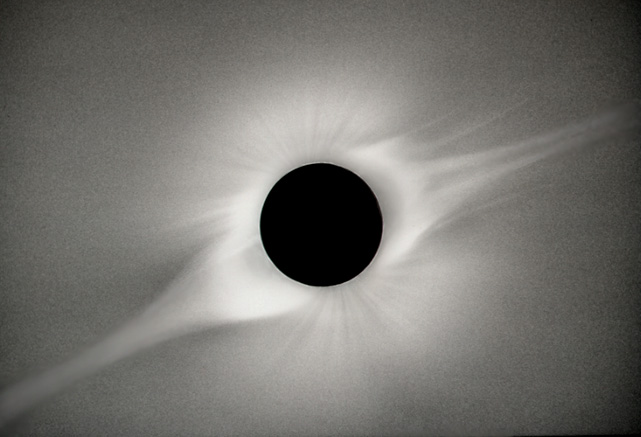
| |
| Outer Corona (Radially Dodged Phtographic Print) | |
| Radially dodged print made from a single slide. The original Kodachrome 64 slide was exposed for 1 second at f/9.5. An elliptical mask having feathered protrusions was used to enhance the equatorial streamers. The slide was printed directly onto black and white Polycontrast paper, producing a negative print. The central part of the print was exposed for only two seconds, while the outer extremes were exposed for up to ninety seconds. Filtration near the center was for a contrast of 4, while that at the edge was for a contrast of 2. The slight unintentional "dent" in the corona at the 5 o'clock position is due to the shadow of a thin dodging wand, showing just how sensitive radial dodging can be. For registration purposes, the outer 20 percent of the equatorial streamers were artificially enhanced on the original print, then darkened and blurred again with digital image processing tools that locally burn in, blur, or reproduce parts of the image. Digital processing was also used to restore the image to a positive. The rest of the image was not locally manipulated, but it does show the potential of combining darkroom and digital image processing techniques. Darkroom techniques can be used to lower the dynamic range of the analog image, thereby simplifying the subsequent scanning procedures. This and all other images © Copyright 1995, 1998 Jeffrey R. Charles. All Rights Reserved. | |

| |
| Outer Corona (Composite Image) | |
| Composite of five radially dodged prints which were made from two different slides. The exposure for both original slides was 1 second at f/9.5 on Kodachrome 64 film. All five negative prints were rephotographed on Kodachrome 64 film, resulting in 5 negatives. These were sandwiched and printed on black and white paper. The object of sandwiching so many negatives was to average out dodging errors. Digital image processing was used to add a uniform background around the corona (though it admittedly does not look very realistic). This image is my first attempt, but even it is reminiscent of the actual appearance of the corona. © Copyright 1995, 1998 Jeffrey R. Charles. All Rights Reserved. | |
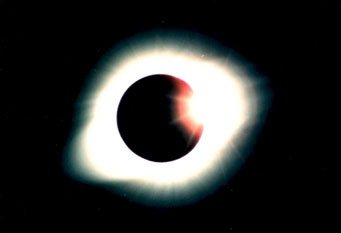 |
 |
| Diamond Ring at End of Totality | |
| The duration of totality was only a minute and forty one seconds, so third contact came all too soon. The left image is a one second exposure, taken only one second after third contact. The right image is a 1/30 second exposure, taken thirteen seconds after third contact. | |
Return to Local Table of Contents
Eclipse Images; Wide Angle Images of the 1995 Lunar Umbra:
 |
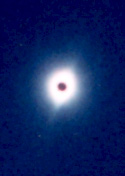 |
| Fisheye Picture of Umbra (175 Deg. FOV); Extreme Enlargement of Totality | |
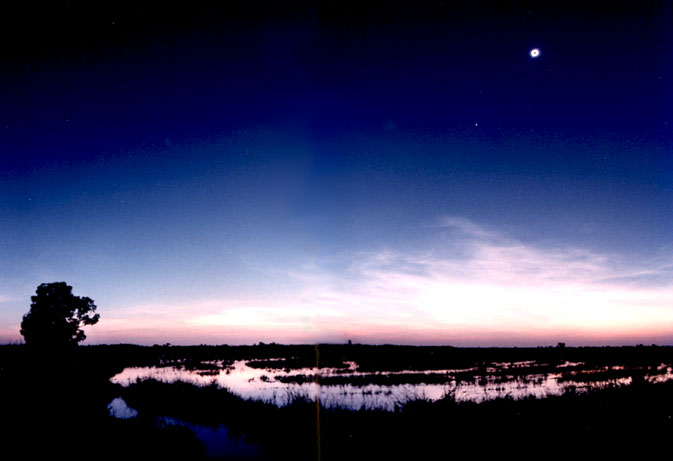 |
|
| Eclipse and Horizon, 14 Seconds After 2nd Contact (145 Degree Field of View) | |
| Total Solar Eclipse and Venus over Thailand, just after second contact. This 145 degree wide by 100 degree high image is made from two of the six pictures used in one of the following 360 degree panoramas. The exposure was 1/4 second at f/4 with a 16 mm fisheye Nikkor lens on ISO 100 print film. The exposure was increased to one full second for subsequent panoramas. The left image was taken at second contact and the right one was taken 14 seconds after second contact. The difference in time resulted in visible motion of the lunar umbra between images. Note the differing angle of the gradient in the sky caused by different umbral positions. |
|
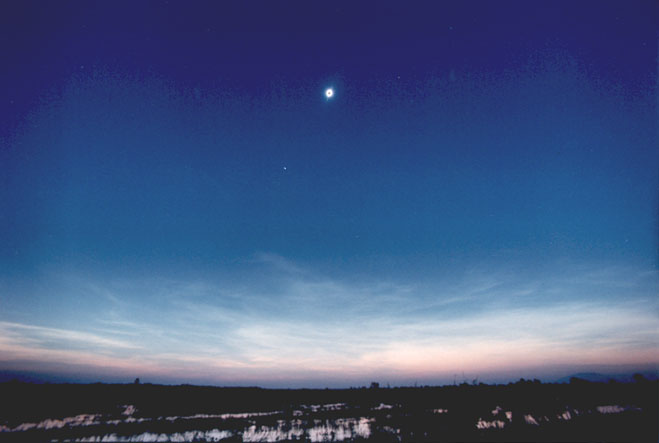 |
|
| Eclipse and Venus Over Horizon, 59 Seconds After 2nd Contact (110 Deg. FOV) | Total Solar Eclipse and Venus over Thailand at 10:47:28 local time; 59 seconds after second contact. Mercury was visible above the eclipse, but it is not discernible in this image. The exposure was 1.5 seconds at f/5.6 with a 14 mm wide angle lens on ISO 100 print film. Compared to the previous image, the leading edge of the umbra is much lower in the sky. Contours in the sky show that the 24 bit color depth of the scanner I used was not quite enough. |
Return to Local Table of Contents
360 Degree Panoramic Images of the Lunar Umbra.
|
The following sequence of panoramic photos show the dramatic approach, arrival, and departure of the lunar umbra. Each panorama covers about 130 degrees vertically by 410 degrees horizontally (for about 50 degrees of horizontal overlap). At this eclipse, the camera was used in a vertical orientation to facilitate the wide vertical coverage needed to include the sun in each panorama. Several panoramas were taken with two different cameras, but the images which were taken several minutes before and after totality are not shown because the umbra is not detectable in them. Local haze obscured the umbra until within three minutes of totality.
Each panorama is made up of a series of six photos which were taken in clockwise order with a Nikon N2020 camera and a 16 mm f/2.8 fisheye Nikkor lens, with the north photo from the end of one panorama being repeated at the beginning of the next one. In order to facilitate the taking of high resolution panoramas in an expeditions manner during the eclipse, Jeffrey R. Charles designed and fabricated an automated control motorized indexing rotary camera platform. The panoramas were taken for both aesthetic and data collection purposes. The data is used to determine the altitudes at which the boundary of the lunar umbra is most prominently projected on the earth's atmosphere. This information is used in predicting the appearance of the lunar umbra and associated phenomena at future total solar eclipses. The low altitude of the eclipse site in Thailand was not as favorable for the experiment as a higher site, but this was more than made up for by the fact that there was no interference in my procedures by local people. The directions North, East, South, and West, all appear immediately below each panorama, with North appearing twice. Local time appears under "South", and the average time before or after second or third contact is shown under "West". For example: "2C-2:06" is shown under the first panorama, indicating that it was taken two minutes and six seconds before the beginning of totality. The exposure time and f/ratio is shown on the right side of each panorama, under "North". All of the panoramas were taken on ISO 100 print film. The panoramas shown below are made from scanning assembled sets of prints, so the resolution and matching is not particularly good. Straight prints do not provide for the negative cylindrical or spherize effects which must be applied in order to prevent the repetition of subject matter in the corners of adjacent fisheye pictures. In these images, the digital clone and blur tools in were used to minimize some of the more obvious repetition. This may cause the images to have some mottling. It is envisioned that better images will be uploaded later. Later images will utilize scans of the original negatives, giving them a quality at least as good as the wide angle umbral shots above. |
| TOTAL SOLAR ECLIPSE OF 24 OCTOBER 1995 |
| 360 DEGREE PANORAMIC IMAGES OF THE LUNAR UMBRA © Copyright 1995, 1998, Jeffrey R. Charles, All Rights Reserved. |
 |
| The Lunar Umbra Approaches Our Eclipse Site | The umbra approaches. The top image was taken an average of two minutes, six seconds before second contact. The dark oval in the northwestern sky is as much the result of natural sky darkening near the zenith (particularly at high elevation angles which oppose the solar azimuth) as it is from the effects of the umbra. This relative sky darkening is accentuated by local haze. The umbra is definitely contributing to localized sky darkening in lower image, which was taken only seconds before totality. © Copyright 1995, 1998, Jeffrey R. Charles, All Rights Reserved. |
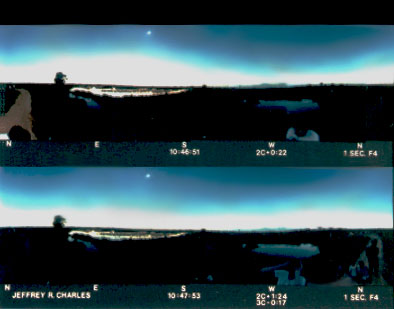 |
| The Umbra Engulfs Our Eclipse Site During Totality |
| The umbra engulfs our eclipse site. The top image was taken near the beginning of totality. This is the panorama from which the previous 145 by 100 degree image was taken. The bottom panorama was taken near the end of totality. Note that the umbral boundary is lower in the east and higher in the west. This difference in umbral position is also discernible by the intensity of reflections in the water at various azimuths. It was not completely dark during totality, so the original images include a great deal of foreground information. |
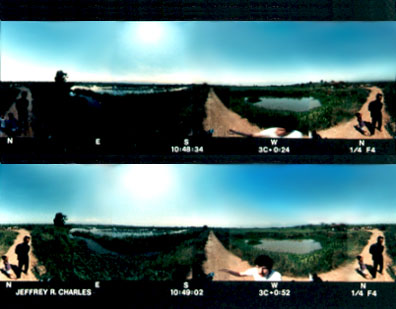 |
| The Lunar Umbra Departs After Totality |
| The umbra departs. The top image was taken only seconds after the end of totality, but the umbra has all but vanished into the eastern haze. The only trace of it is a subtle darkening in the southeastern sky, below the sun. In this panorama, the ground brightness increases from left to right due to the rapidly brightening local sunlight. The indexing rotary panoramic camera platform is capable of taking panoramas fast enough to prevent much change in density, but the panoramas were taken at slow rate in order conserve film and get a good sampling of incident light intensity vs. time. The bottom image was taken less than a minute after the end of totality, but the natural sky darkening at high elevation angles which oppose the solar azimuth has already begun to reappear. |
Return to Local Table of Contents
Instrumentation:
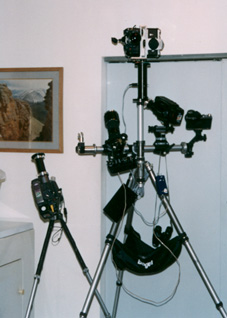 |
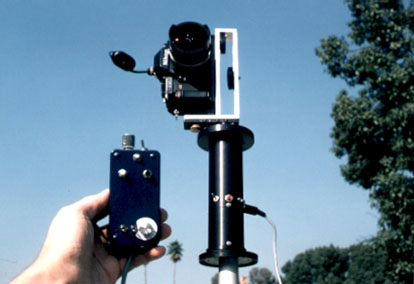 |
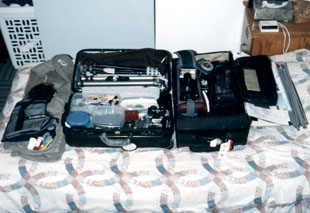 |
|
| Equipment set up to practice procedures before departure | |
| The LEFT image shows all of the equipment except one video camera mounted on a Gitzo 326 tripod with a Bogen cross bar attachment. The small blue control box near the top of the right tripod leg includes circuitry to automate operation of the indexing rotary camera platform, one of the cameras on it, and a camera on the 300 mm ED Nikkor lens, shown just left of the tripod center column. In order to minimize camera shake, the automated control synchronizes the cameras so they will not fire while the indexing platform is rotating. A video camera with a home made 3x converter lens is on a separate tripod in order to isolate it from vibrations caused by operation of the equipment on the other tripod. The UPPER RIGHT image shows a close up of the Versarama (TM) indexing rotary camera platform and its remote automated control. The right angle bracket on top allows two cameras to be attached with their entrance pupils equal distances from the center of rotation for stereo imaging, or one camera to be positioned directly over the center. The camera is offset here because a second camera was intermittently used on the other side of the bracket. The LOWER RIGHT image shows how all of the equipment fits into two standard carry on bags. The photo vest (shown beside the luggage) has a lot of pockets for toting a few extra items. |
|

| |
| 300 mm ED Nikkor lens combined with the Versacorp DiaGuider | |
| 300 mm f/4.5 ED Nikkor lens adapted to the patented Versacorp DiaGuider via the prototype VersaScope adapter. The adapter includes a special cell which positions a Dakin Barlow lens a modest distance into the rear recess of the lens. This increases the effective focal length to 640 mm and compensates for the extra back focus required for the depth of the DiaGuider. The image can be instantly switched between the eyepiece and camera with the DiaGuider, making it possible to observe and photograph the eclipse with one highly portable instrument. |
|
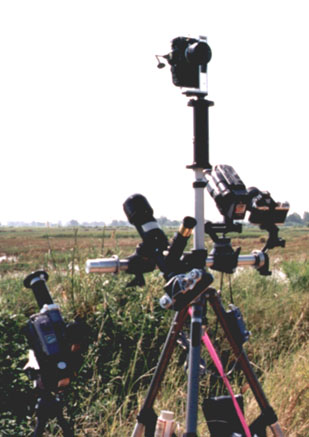 |
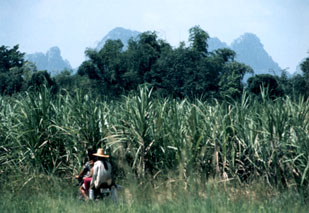 |
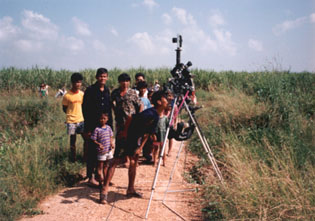 |
|
| Instrumentation set up at eclipse site in Thailand | |
| The left image shows the equipment set up at the eclipse site in Thailand. Note the similarity to how the equipment was set up prior to the expedition. Planning and practice of equipment setup and imaging procedures is an important part of a successful photographic eclipse expedition. The upper right image shows the bucolic surroundings at our site. The lower right image shows a few local people who enjoyed the eclipse with us. |
|
Return to Local Table of Contents
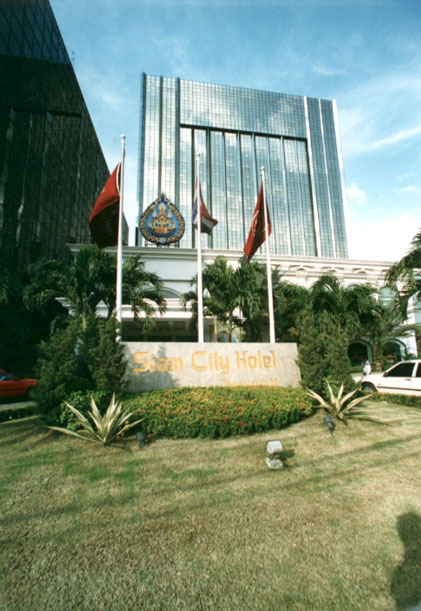 |
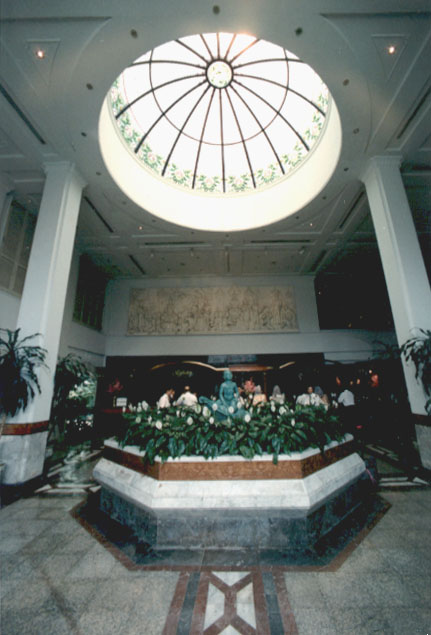 |
| The luxurious Siam City Hotel, a place with a very friendly staff. | Lobby of the Siam City Hotel, showing its ornate glass dome. |
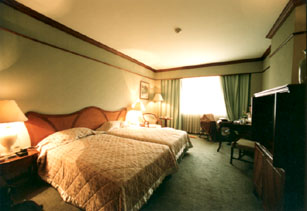 |
 |
| Room 1070 at the Siam City Hotel | Our marble rest room - with a telephone! |
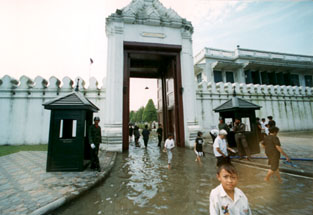 |
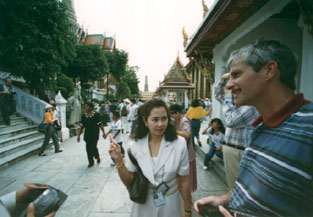 |
| Local flooding in Bangkok | Pierre with our pleasant tour guide |
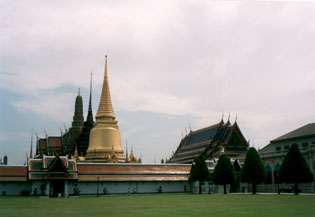 |
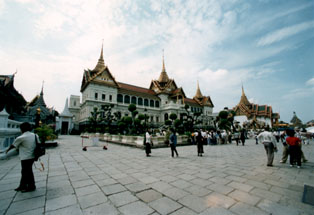 |
| Grounds of the Grand Palace | The Grand Palace |
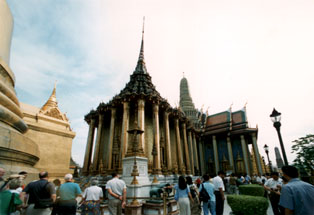 |
 |
| Chapel Royal (temple) of the Emerald Buddha | Ornate wall painting near temple of the Emerald Buddha |
Light Intensity Graph for 24 Oct. 1995 Total Solar Eclipse
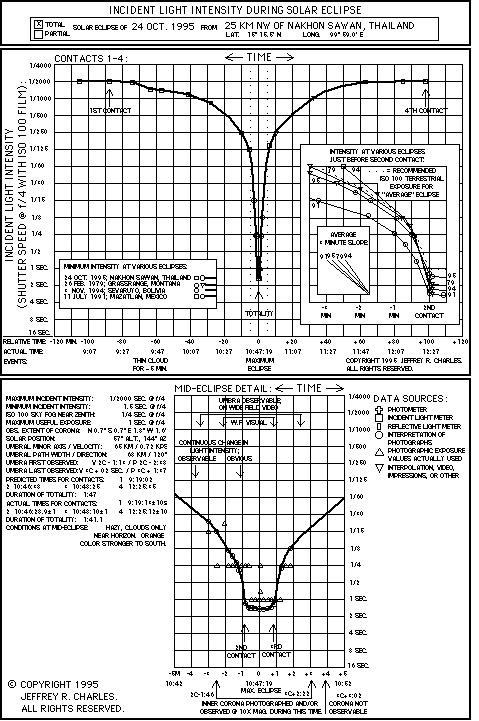 |
|
Recommended Reading:
Light intensity graph for the 1995 eclipse, by Jeffrey R. Charles Steps to a Successful Eclipse Expedition, by Jeffrey R. Charles Use of material herein is subject to conditions in the Versacorp Legal Information Page. Need information about eclipses for your planetarium, motion picture, or other project? Jeffrey R. Charles performs science consulting in regard to eclipse phenomena and instrumentation. Please direct inquiries to Jeffrey R. Charles (jcharles *at* versacorp dot com) or visit the www.versacorp.com web site for more information about total solar eclipse related science and engineering consulting. |
|
Return to Local Table of Contents |
|
© Copyright 1995, 1998, 2017 Jeffrey R. Charles. All Rights Reserved. Jeffrey R. Charles (jcharles *at* eclipsechaser dot com)
Document created: 17 March, 1998 |